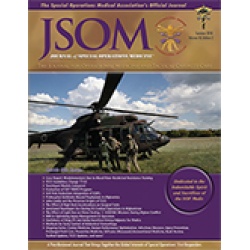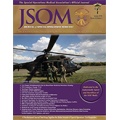Management of Suspected Tension Pneumothorax in Tactical Combat Casualty Care: TCCC Guidelines Change 17-02
Butler FK, Holcomb JB, Shackelford S, Montgomery HR, Anderson S, Cain JS, Champion HR, Cunningham CW, Dorlac WC, Drew B, Edwards K, Gandy JV, Glassberg E, Gurney J, Harcke T, Jenkins DA, Johannigman J, Kheirabadi BS, Kotwal RS, Littlejohn LF, Martin M, Mazuchowski EL, Otten EJ, Polk T, Rhee P, Seery JM, Stockinger Z, Torrisi J, Yitzak A, Zafren K, Zietlow SP 18(2). 19 - 35 (Journal Article)
This change to the Tactical Combat Casualty Care (TCCC) Guidelines that updates the recommendations for management of suspected tension pneumothorax for combat casualties in the prehospital setting does the following things: (1) Continues the aggressive approach to suspecting and treating tension pneumothorax based on mechanism of injury and respiratory distress that TCCC has advocated for in the past, as opposed to waiting until shock develops as a result of the tension pneumothorax before treating. The new wording does, however, emphasize that shock and cardiac arrest may ensue if the tension pneumothorax is not treated promptly. (2) Adds additional emphasis to the importance of the current TCCC recommendation to perform needle decompression (NDC) on both sides of the chest on a combat casualty with torso trauma who suffers a traumatic cardiac arrest before reaching a medical treatment facility. (3) Adds a 10-gauge, 3.25-in needle/ catheter unit as an alternative to the previously recommended 14-gauge, 3.25-in needle/catheter unit as recommended devices for needle decompression. (4) Designates the location at which NDC should be performed as either the lateral site (fifth intercostal space [ICS] at the anterior axillary line [AAL]) or the anterior site (second ICS at the midclavicular line [MCL]). For the reasons enumerated in the body of the change report, participants on the 14 December 2017 TCCC Working Group teleconference favored including both potential sites for NDC without specifying a preferred site. (5) Adds two key elements to the description of the NDC procedure: insert the needle/ catheter unit at a perpendicular angle to the chest wall all the way to the hub, then hold the needle/catheter unit in place for 5 to 10 seconds before removing the needle in order to allow for full decompression of the pleural space to occur. (6) Defines what constitutes a successful NDC, using specific metrics such as: an observed hiss of air escaping from the chest during the NDC procedure; a decrease in respiratory distress; an increase in hemoglobin oxygen saturation; and/or an improvement in signs of shock that may be present. (7) Recommends that only two needle decompressions be attempted before continuing on to the "Circulation" portion of the TCCC Guidelines. After two NDCs have been performed, the combat medical provider should proceed to the fourth element in the "MARCH" algorithm and evaluate/treat the casualty for shock as outlined in the Circulation section of the TCCC Guidelines. Eastridge's landmark 2012 report documented that noncompressible hemorrhage caused many more combat fatalities than tension pneumothorax.1 Since the manifestations of hemorrhagic shock and shock from tension pneumothorax may be similar, the TCCC Guidelines now recommend proceeding to treatment for hemorrhagic shock (when present) after two NDCs have been performed. (8) Adds a paragraph to the end of the Circulation section of the TCCC Guidelines that calls for consideration of untreated tension pneumothorax as a potential cause for shock that has not responded to fluid resuscitation. This is an important aspect of treating shock in combat casualties that was not presently addressed in the TCCC Guidelines. (9) Adds finger thoracostomy (simple thoracostomy) and chest tubes as additional treatment options to treat suspected tension pneumothorax when further treatment is deemed necessary after two unsuccessful NDC attempts-if the combat medical provider has the skills, experience, and authorizations to perform these advanced interventions and the casualty is in shock. These two more invasive procedures are recommended only when the casualty is in refractory shock, not as the initial treatment.


 Español
Español 




